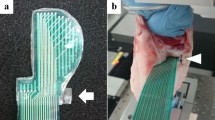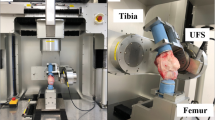Abstract
Purpose
To clarify the effect of the radial tear of the lateral meniscus on the in situ meniscus force and the tibiofemoral relationship under axial loads and valgus torques.
Methods
Ten intact porcine knees were settled to a 6-degree of freedom robotic system, while the force and 3-dimensional path of the knees were recorded via Universal Force Sensor (UFS) during 3 cycles of 250-N axial load and 5-Nm valgus torque at 15°, 30°, 45°, and 60° of knee flexion. The same examination was performed on the following 3 meniscal states sequentially; 33, 66, and 100% width of radial tears at the middle segment of the lateral meniscus, while recording the force and path of the knees via UFS. Finally, all paths were reproduced after total lateral meniscectomy and the in situ force of the lateral meniscus were calculated with the principle of superposition.
Results
The radial tear of 100% width significantly decreased the in situ force of the lateral meniscus and caused tibial medial shift and valgus rotation at 30°–60° of knee flexion in both testing protocols. Under a 250-N axial load at 60° of knee flexion, the in situ force decreased to 36 ± 29 N with 100% width of radial tear, which was 122 ± 38 N in the intact state. Additionally, the tibia shifted medially by 2.1 ± 0.9 mm and valgusrotated by 2.5 ± 1.9° with the complete radial tear. However, the radial tear of 33 or 66% width had little effect on either the in situ force or the tibial position.
Conclusion
A radial tear of 100% width involving the rim significantly decreased the in situ force of the lateral meniscus and caused medial shift and valgus rotation of the tibia, whereas a radial tear of up to 66% width produced only little change. The clinical relevance is that loss of meniscal functions due to complete radial tear can lead to abnormal stress concentration in a focal area of cartilage and can increase the risk of osteoarthritis in the future.





Similar content being viewed by others
References
Allaire R, Muriuki M, Gilbertson L, Harner CD (2008) Biomechanical consequences of a tear of the posterior root of the medial meniscus: similar to total meniscectomy. J Bone Joint Surg Am 90(9):1922–1931
Allen CR, Wong EK, Livesay GA, Sakane M, Fu FH, Woo SL (2000) Importance of the medial meniscus in the anterior cruciate ligament-deficient knee. J Orthop Res 18(1):109–115
Bedi A, Kelly N, Baad M, Fox AJ, Ma Y, Warren RF, Maher SA (2012) Dynamic contact mechanics of radial tears of the lateral meniscus: implications for treatment. Arthroscopy 28(3):372–381
Defrate LE, Papannagari R, Gill TJ, Moses JM, Pathare NP, Li G (2006) The 6 degrees of freedom kinematics of the knee after anterior cruciate ligament deficiency: an in vivo imaging analysis. Am J Sports Med 34(8):1240–1246
Fujie H, Livesay GA, Fujita M, Woo SL-Y (1996) Forces and moments in 6-DOF at the human joint: mathematical description for control. J Biomech 29:1577–1585
Fujie H, Sekito T, Orita A (2004) A novel robotic system for joint biomechanical tests: application to the human knee joint. J Biomech Eng 126:54–61
Fujie H, Otsubo H, Fukano S, Suzuki T, Suzuki D, Mae T, Shino K (2011) Mechanical functions of the three bundles consisting of the human anterior cruciate ligament. Knee Surg Sports Traumatol Arthrosc 19(Suppl 1):S47–S53
Grood ES, Suntay WJ (1983) A joint coordinate system for the clinical description of three-dimensional motions: application to the knee. J Biomech Eng 105(2):136–144
Hosseini A, Van de Velde SK, Gill TJ, Li G (2012) Tibiofemoral cartilage contact biomechanics in patients after reconstruction of a ruptured anterior cruciate ligament. J Orthop Res 30(11):1781–1788
Jaspers P, Lange A, Huiskes R, van Rens T (1980) The mechanical function of the meniscus experiments on cadaveric pig knee-joints. Acta Orthop Belg 46:663–668
Jones RS, Keene GC, Learmonth DJ, Bickerstaff D, Nawana NS, Costi JJ, Pearcy MJ (1996) Direct measurement of hoop strain in the intact and torn human medial meniscus. Clin Biomech 34:295–300
Joshi MD, Suh JK, Marui T, Woo SL (1995) Interspecies variation of compressive biomechanical properties of the meniscus. J Biomed Mater Res 29(7):823–828
Lerer DB, Umans HR, Hu MX, Jones MH (2004) The role of meniscal root pathology and radial meniscal tear in medial meniscal extrusion. Skelet Radiol 33(10):569–574
Li G, Park SE, DeFrate LE, Schutzer ME, Ji L, Gill TJ, Rubash HE (2005) The cartilage thickness distribution in the tibiofemoral joint and its correlation with cartilage-to-cartilage contact. Clin Biomech (Bristol, Avon) 20(7):736–744
Markolf KL, Jackson SR, McAllister DR (2012) Force measurements in the medial meniscus posterior horn attachment: effects of anterior cruciate ligament removal. Am J Sports Med 40(2):332–338
Messner K, Gao J (1998) The menisci of the knee joint. Anatomical and functional characteristics, and a rationale for clinical treatment. J Anat 193(Pt 2):161–178
Ode GE, Van Thiel GS, McArthur SA, Dishkin-Paset J, Leurgans SE, Shewman EF, Wang VM, Cole BJ (2012) Effects of serial sectioning and repair of radial tears in the lateral meniscus. Am J Sports Med 40(8):1863–1870
Proffen BL, McElfresh M, Fleming BC, Murray MM (2012) A comparative anatomical study of the human knee and six animal species. Knee 19(4):493–499
Schillhammer CK, Werner FW, Scuderi MG, Cannizzaro JP (2012) Repair of lateral meniscus posterior horn detachment lesions: a biomechanical evaluation. Am J Sports Med 40(11):2604–2609
Setton LA, Guilak F, Hsu EW, Vail TP (1999) Biomechanical factors in tissue engineered meniscal repair. Clin Orthop Relat Res 367(Suppl):S254–S272
Terzidis IP, Christodoulou A, Ploumis A, Givissis P, Natsis K, Koimtzis M (2006) Meniscal tear characteristics in young athletes with a stable knee: arthroscopic evaluation. Am J Sports Med 34(7):1170–1175
Van de Velde SK, Bingham JT, Hosseini A, Kozanek M, DeFrate LE, Gill TJ, Li G (2009) Increased tibiofemoral cartilage contact deformation in patients with anterior cruciate ligament deficiency. Arthritis Rheum 60(12):3693–3702
Yoon KH, Lee SH, Bae DK, Park SY, Oh H (2013) Does varus alignment increase after medial meniscectomy? Knee Surg Sports Traumatol Arthrosc 21(9):2131–2136
Author information
Authors and Affiliations
Corresponding author
Ethics declarations
Conflict of interest
The authors declare that they have no conflict of interest.
Funding
This work was supported by a grant from Japan Society for the Promotion of Science, JSPS KAKENHI Grant Number JP26462293.
Ethical approval
This article does not contain any studies with animals performed by any of the authors because all the knee specimen were obtained from the edible pigs of the local butcher.
Rights and permissions
About this article
Cite this article
Tachibana, Y., Mae, T., Fujie, H. et al. Effect of radial meniscal tear on in situ forces of meniscus and tibiofemoral relationship. Knee Surg Sports Traumatol Arthrosc 25, 355–361 (2017). https://doi.org/10.1007/s00167-016-4395-4
Received:
Accepted:
Published:
Issue Date:
DOI: https://doi.org/10.1007/s00167-016-4395-4




